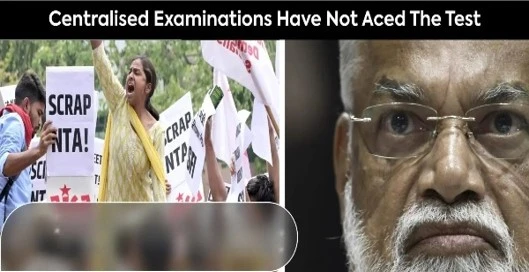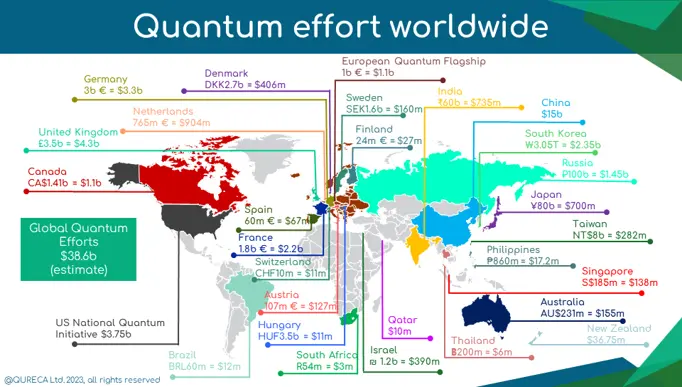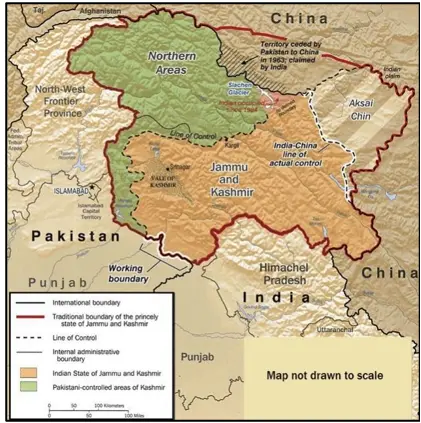Friday, 19th July 2024
NITI Aayog Suggests Measures Revitalise Electronics Industry
Why in the news?
- NITI Aayog has released a report titled “Electronics: Powering India’s Participation in Global Value Chains,” proposing measures to grow India’s electronics sector from $100 billion to $500 billion by 2030.
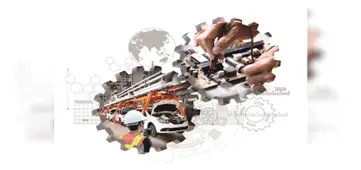
Electronics Sector in India:
- Background:
- Current Status: India’s electronics manufacturing largely involves final assembly. Design and component manufacturing remain underdeveloped.
- Trends: Increased outsourcing of assembly, testing, and packaging to Electronic Manufacturing Services (EMS) companies in India.
- Statistics:
- Growth: The electronics sector reached USD 155 billion in FY23, up from USD 48 billion in FY17.
- Components: USD 86 billion in finished goods and USD 15 billion in components.
- Mobile Phones: Constitute 43% of total electronics production.
- Domestic Production: India now manufactures 99% of its smartphones domestically.
- Global Scenario:
- Market Share: The global electronics market is valued at USD 4.3 trillion, with major players including China, Taiwan, USA, South Korea, Vietnam, and Malaysia.
- Exports: India exports approximately USD 25 billion annually, less than 1% of the global share despite holding 4% of global demand.
What are the Government Initiatives?
- FDI Policies: 100% FDI allowed under the automatic route; For defence electronics, FDI up to 49% is automatic; beyond 49% requires government approval.
- Schemes:
- Production Linked Incentive Scheme (PLI): For Large Scale Electronics Manufacturing and IT Hardware.
- Scheme for Promotion of Manufacturing of Electronic Components and Semiconductors (SPECS).
- Modified Electronics Manufacturing Clusters Scheme (EMC 2.0).
- Semicon India Program: $10 billion incentive to develop semiconductor and display ecosystems.
- Other Schemes: Digital India, Make In India, Phased Manufacturing Program, Electronics Cluster Manufacturing Scheme, Electronics Development Fund.
Challenges:
- High Import Tariffs: Elevated import tariffs and a complex tariff structure (0%-20%+) increase costs and compliance issues, making products less globally competitive.
- Component Ecosystem: Absence of a robust ecosystem for high-complexity components and difficulty in attracting global brands limit India’s role in the global market.
- High Capital Costs: India’s financing costs (9%-13%) are higher compared to countries like China (4%), Malaysia (3.5%), and Mexico (2.7%).
- R&D and Design: Insufficient infrastructure, talent, and skilling in R&D and design.
Key Highlights of the Report:
- Target:
- USD 500 Billion by 2030:
- Finished Goods: USD 350 billion.
- Components Manufacturing: USD 150 billion.
- Employment: Expected to create approximately 6 million jobs.
- USD 500 Billion by 2030:
- Projections in a Business as Usual (BAU) Scenario:
- FY30 Projection: USD 278 billion.
- Finished Goods: USD 253 billion.
- Components Manufacturing: USD 25 billion.
- FY30 Projection: USD 278 billion.
- Strategic Interventions Needed:
- Component and Capital Goods Manufacturing: Promote local manufacturing.
- Incentivize R&D and Design: Enhance research and development efforts.
- Tariff Rationalisation: Simplify and rationalise the tariff structure.
- Skilling Initiatives: Focus on talent development and training.
- Technology Transfer: Facilitate smooth technology transfers.
- Infrastructure Development: Strengthen the electronics manufacturing ecosystem.
- Focus Areas:
- Established Segments: Scale production in mobile phones.
- Emerging Areas: Expand into wearables, IoT devices, and automotive electronics.
- Competitiveness: Localise high-tech components, improve design capabilities, and form partnerships with global technology leaders.
- Recommendations:
- Fiscal Support: Provide support to design-focused companies.
- Skill Development: Expedite visa approvals for training and establish Electronics Skill Training Hubs.
- Technology Transfer: Develop mechanisms for fast-tracking approvals under Press Note 3 (2020) to attract foreign investment crucial for ecosystem development
Source: IE
UNEP Foresight Report 2024
Why in the news?
- Recently, the United Nations Environment Programme (UNEP) released the report titled "Navigating New Horizons: A Global Foresight Report on Planetary Health and Human Wellbeing, 2024."
- The report emphasises 8 critical global shifts that are exacerbating the triple planetary crisis of climate change, biodiversity loss, nature loss, and pollution.
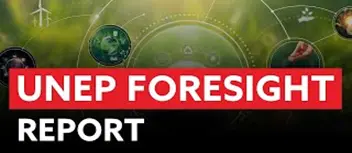
Key Highlights of the UNEP Report:
- No Significant Progress in UN SDG Goals:
- As of the latest 2023 SDG Progress Report, 85% of the 169 Sustainable Development Goals (SDG) targets are off track, with 37% showing no progress or regressing since 2015.
- 42.85% of the targets for SDG 6 (Clean Water and Sanitation), SDG 13 (Climate Action), SDG 14 (Life Below Water), and SDG 15 (Life on Land) are either stagnating or deteriorating.
- 60% of environmental indicators are either worsening or have unclear status.
- 8 Critical Shifts and 18 Signals of Change:
- The report identifies 8 significant shifts and 18 potential signals of change. These signals, which may have significant future impacts, are early indicators that could be positive or negative.
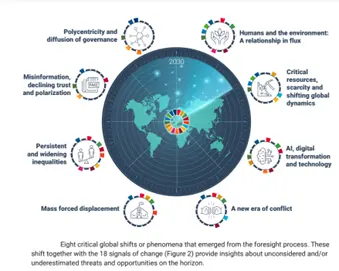
- Rapidly Changing Human-Environment Relationship:
- Human activities are expected to impact over 90% of land by 2050, with up to 46% of species at risk of extinction.
- Global temperatures are projected to rise between 2.1°C and 3.9°C by 2100, driven primarily by greenhouse gas emissions from fossil fuels, mostly contributed by developed nations.
- Scarcity and Competition for Critical Resources:
- Global competition for critical resources is increasing, leading to volatility and potential conflicts, particularly in resource-rich areas.
- Fundamental resources like water and food face growing threats from climate change and poor management, disproportionately impacting vulnerable populations.
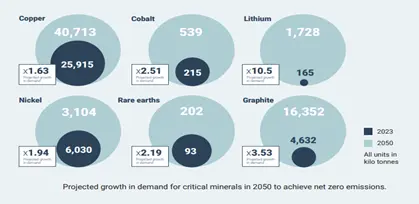
- Advancement in AI, Digital Transformation, and Technology:
- Rapid advancements in digital technologies and AI are driven by mobile devices, internet access, and growing AI capabilities.
- There are over 8.89 billion mobile subscriptions, and 67.4% of the global population were internet users in 2023.
- However, the environmental implications of these technologies need to be addressed.
- Emergence of a New Era of Conflict:
- The report warns of potential major global disruptions from AI-based and autonomous weapons within 4-6 years without human oversight.
- Examples include AI-equipped drones used in the Russia-Ukraine conflict and the risk of AI-controlled bioweapons.
- There is a 59% likelihood of such disruptions, with high perceived impact.
- Mass Forced Displacement:
- 1.5% of the global population is currently forcibly displaced, nearly double the figure from a decade ago.
- Climate change is a major driver, with extreme conditions like wildfires and flooding contributing to displacement.
- Regions such as Africa, Central America, the Pacific Islands, and South Asia face higher risks of climate-induced migration.
- By 2070, up to 3 billion people could live outside suitable climate conditions, with environmental migrants potentially numbering between 25 million and 1 billion by 2050.
- Internally displaced persons have increased by 340% over 20 years.

- Widening Inequalities:
- Global inequality is worsening, with the top 10% holding over 75% of wealth, while the bottom 50% possess just 2%.
- Inequality within nations is driven by unequal access to education, jobs, and services, exacerbated by globalisation.
- Wealth inequality leads to ecological inequities, with the wealthy contributing more to climate change while the poor suffer the most.
- Misinformation, Declining Trust, and Polarisation:
- Erosion of trust in science and public institutions undermines evidence-based policymaking and democratic governance.
- This decline, fuelled by perceived failures and misinformation, makes it challenging to implement effective policies to address issues like the climate crisis
Future Outlook and Recommendations of UNEP:
- Broadening Stakeholder Engagement: Engage diverse stakeholders, including women and youth, using technology to boost participation, fight misinformation, and build trust.
- Stronger Voice for Young People: Involve young people in decision-making at all governance levels to ensure generational equity.
- Redefining Progress Beyond GDP: Use broader indicators like the Inclusive Wealth Index to guide investments and achieve Sustainable Development Goals.
- Community Empowerment: Support agile governance that allows communities to innovate and set flexible long-term environmental goals.
- Data-Driven Decision-Making: Leverage data and monitoring to inform evidence-based policymaking and enhance environmental oversight.
- Sustainable Prosperity: Transform economies to thrive within environmental limits, emphasising equity, sustainability, and resilience.
What is UNEP?
- About:
- The United Nations Environment Programme (UNEP) is a leading global environmental authority established on June 5, 1972.
- It sets the global environmental agenda, promotes sustainable development within the United Nations system, and advocates for global environmental protection.
- Major Reports:
- Emission Gap Report, Adaptation Gap Report, Global Environment Outlook, Frontiers, Invest into Healthy Planet
- Major Campaigns:
- Beat Pollution, UN75, World Environment Day, Wild for Life
- Headquarters: Nairobi, Kenya.
|
UPSC Civil Services Examination Previous Year Question Prelims Q:1 The ‘Common Carbon Metric’, supported by UNEP, has been developed for
Ans: (a)
Mains Q:1 Discuss global warming and mention its effects on the global climate. Explain the control measures to bring down the level of greenhouse gases which cause global warming, in the light of the Kyoto Protocol, 1997. (2022) |
Source: UNEP
The State of India’s Informal Economy
Why in the news?
- According to the Annual Survey of Unincorporated Enterprises (ASUSE), the informal sector in India faces many challenges.
- Over the last seven years, many small and medium enterprises have shut down, resulting in the loss of about 16.45 lakh jobs.
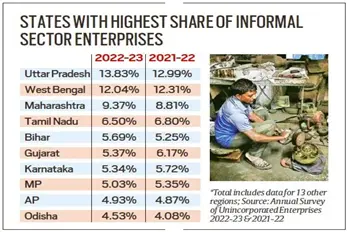
Meaning of the Informal Sector of the Economy:
- Terminology:
- The terms unorganised and informal sector are used interchangeably in the Indian context.
- Composition:
- Includes small and medium enterprises and household proprietary and partnership establishments.
- Economic Contribution:
- Contributes over 44% to the country’s gross value added (GVA) and employs nearly 75% of the workforce in non-agricultural enterprises.
- The sector accounts for almost half of India’s economic output and more than three-fourths of employment.
- Sectoral Distribution:
- The highest share of the unorganised sector is in agriculture due to small and fragmented holdings.
- Other significant sectors include trade, construction, real estate, professional services, etc.
Key characteristic of the informal sector:
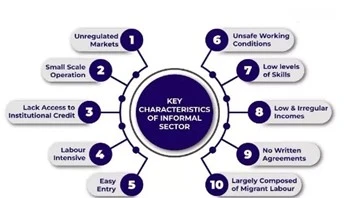
About the ASUSE:
- Release:
- The ASUSE was released for the years 2021-22 and 2022-23 by the Union Ministry of Statistics and Programme Implementation (MoSPI).
- Scope:
- Surveys unincorporated non-agricultural establishments in three sectors: manufacturing, trade, and other services.
- Targets unincorporated enterprises, comprising MSMEs, household units (including those with hired workers), and own-account enterprises.
- Includes manufacturing units not covered under the Factories Act 1948 and the organised manufacturing sector covered by the Annual Survey of Industries (ASI).
- Coverage:
- Under trade and other services, the survey includes proprietary and partnership establishments (excluding LLPs), cooperatives, self-help groups, non-profit institutions, etc.
Key Highlights of the ASUSE:

- Employment in the Informal Sector:
- The number of workers employed in the informal sector in 2022-23 has decreased by 16.45 lakh, or about 1.5%, to 10.96 crore, compared to 11.13 crore in 2015-16.
- Increase in Unincorporated Enterprises:
- The number of unincorporated enterprises increased by 16.56 lakh, rising to 6.50 crore in 2022-23 from 6.33 crore in 2015-16.
- Growth in Real GVA:
- The real GVA of unincorporated sector enterprises grew by 6.9% in 2022-23, although this remains lower than the pre-pandemic level.
What is the significance of the ASUSE Data?
- A Crucial Employment Indicator:
- The informal sector is closely monitored for its capacity to generate employment and absorb the labour force, particularly semi-skilled and unskilled labour.
- Impact of Three Major Shocks:
- The data, available for the first time since 2015-16, provides insights into the impact of three major exogenous shocks on the growth of unincorporated enterprises and employment:
- Demonetisation (November 2016)
- Rollout of Goods and Services Tax (July 2017)
- Covid-19 Pandemic (March 2020)
- The informal sector has borne much of the brunt of these shocks.
- The data, available for the first time since 2015-16, provides insights into the impact of three major exogenous shocks on the growth of unincorporated enterprises and employment:
- State-Specific Data:
- States like Maharashtra, Bihar, Gujarat, Madhya Pradesh, and Odisha recorded an increase in informal employment between 2015-16 and 2022-23.
- States like Uttar Pradesh, West Bengal, Tamil Nadu, Karnataka, and Andhra Pradesh registered a decline in the number of informal sector workers during the same period.
- These ten states account for nearly three-quarters of the informal sector workers employed in India.
- Broad Decline in Employment Quality:
- Most new jobs in the sector were created in own-account enterprises rather than hired-worker units, indicating a decline in the quality of employment.
- Correlation with Periodic Labour Force Survey (PLFS):
- The findings match the PLFS 2022-23 data, which shows an increase in workers in agriculture and a decrease in manufacturing.
|
UPSC Civil Services Examination, Previous Year Questions (PYQs) Mains Q:1 How globalisation has led to the reduction of employment in the formal sector of the Indian economy? Is increased informalization detrimental to the development of the country? (2016) |
Source: IE
SEBI’s Proposal on New Asset Class
Why in the news?
- Recently, the Securities and Exchange Board of India (SEBI) has proposed a new asset class designed to bridge the gap between mutual funds and portfolio management services (PMS).
- This new class aims to cater to investors with investible funds ranging from Rs 10 lakh to Rs 50 lakh.
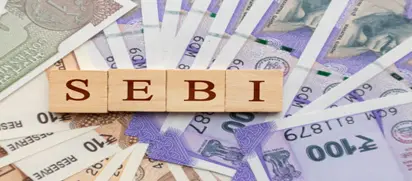
About Securities and Exchange Board of India (SEBI):
- Establishment:
- SEBI is a statutory regulatory body established by the Government of India in 1992, endowed with statutory powers through the SEBI Act, 1992.
- Objective:
- Regulate the securities market in India and protect the interests of investors in securities.
- Formation Rationale:
- SEBI was created to address unfair practices and protect investors. It serves three key groups:
- Issuers: Provides a marketplace for efficient and fair fundraising.
- Intermediaries: Offers a professional and competitive market environment.
- Investors: Ensures protection and accurate information.
- SEBI was created to address unfair practices and protect investors. It serves three key groups:
- Powers of SEBI:
- Quasi-Judicial:
- Powers to pass judgments in cases of fraud and unethical practices to ensure market transparency and fairness.
- Quasi-Executive:
- Powers to examine financial records, impose rules, pass judgments, and take legal actions against violators.
- Quasi-Legislative:
- Powers to formulate rules and regulations to protect investor interests, including listing obligations, insider trading regulations, and disclosure requirements.
- Quasi-Judicial:
SEBI’s Proposal on New Asset Class:
- Overview:
- SEBI has proposed a new asset class to bridge the gap between mutual funds and PMS, targeting investors with higher risk appetites and offering potentially higher returns.
- Need for the New Asset Class:
- Identified gap in the investment spectrum:
- Mutual funds cater to retail investors with varying risk levels.
- PMS and alternative investment funds (AIFs) serve high-net-worth individuals.
- The new asset class provides an intermediate option with higher returns and risks.
- Identified gap in the investment spectrum:
- Investment Strategies:
- Long-Short Equity Funds:
- Involves both long and short positions in equity and related instruments.
- Inverse ETFs/Funds:
- Aims to generate returns negatively correlated with the underlying index.
- Long-Short Equity Funds:
- Global Availability:
- Similar strategies are available globally:
- In the US, regulated by the SEC, long-short equity funds and inverse ETFs offer hedge fund-like strategies with mutual fund liquidity.
- Australia offers various inverse ETF products for hedging against market downturns or speculating on declines.
- Similar strategies are available globally:
- Investment Threshold:
- Minimum investment requirement is Rs 10 lakh per investor, aimed at attracting investors with an investible surplus between Rs 10 lakh and Rs 50 lakh.
- Investors may use Systematic Investment Plans (SIP), Systematic Withdrawal Plans (SWP), and Systematic Transfer Plans (STP).
- The total invested amount must not fall below Rs 10 lakh due to withdrawals or systematic transactions.
- Eligibility for Launch:
- Mutual funds with an average AUM exceeding Rs 10,000 crore over three years or those managed by experienced CIOs and fund managers are eligible.
- Proposed Relaxations:
- Debt Securities:
- Limited to 10% of NAV, extendable to 12% with approval, and up to 20% with further approval.
- Credit Risk-Based Limits:
- Ranges from 10% for AAA-rated securities to 6% for A-rated and below, each extendable by 2 to 5 percent with approval.
- Debt Securities:
Conclusion:
- SEBI's proposed new asset class aims to provide a regulated, flexible investment option that addresses the gaps between mutual funds and PMS. By targeting sophisticated investors and managing risks effectively, this initiative seeks to enhance investment options and curb unauthorised investments.
|
UPSC Civil Services Examination, Previous Year Question (PYQ) Prelims Q:1 Which of the following is issued by registered foreign portfolio investors to overseas investors who want to be part of the Indian stock market without registering themselves directly? (2019)
Ans: (d) |
Source: IE
Shadow Cabinets in Parliamentary Democracies
Why in the news?
- Recently, the leader of the Opposition (LoP) and president of the Biju Janata Dal (BJD) formed a 'shadow cabinet' comprising 50 BJD Members of the Legislative Assembly (MLAs) in Odisha.
- This move follows the Bhartiya Janata Party's recent electoral successes in the state and signifies a notable shift in legislative dynamics.
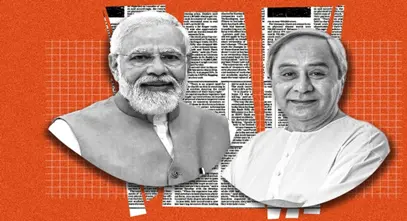
What is a Shadow Cabinet?
- About:
- A shadow cabinet consists of opposition MLAs/MPs who mirror the portfolios of government ministers.
- Led by the LoP, it monitors and critiques the actions of the ruling government across various departments and ministries.
- Originating from the Westminster system, it is used in countries like the UK, Australia, Canada, and New Zealand.
- Benefits:
- Expertise: MPs gain detailed knowledge of specific ministries, enhancing their ability to challenge government policies.
- Leadership Experience: Provides opposition MPs with leadership experience, preparing them for future ministerial roles.
- Democratic Oversight: Ensures robust scrutiny of executive actions, fostering informed debates and preventing hasty decisions.
- Challenges and Criticisms:
- Coordination Issues: In India’s multi-party system, achieving a unified shadow cabinet is challenging due to differing party priorities.
- Narrow Focus: Critics argue that focusing on specific ministries might limit MPs' understanding of broader governance issues, though periodic reshuffles can mitigate this.
- Variable Recognition: Recognition and institutionalisation of shadow cabinets vary, impacting their effectiveness.
Potential Implications for Indian Democracy:
- Strengthened Oversight: Institutionalising a shadow cabinet can enhance parliamentary oversight, ensuring thorough debate and justification of legislative actions.
- Enhanced Trust: Providing coherent policy alternatives can boost public trust in parliamentary proceedings, presenting opposition parties as credible governance alternatives.
- Policy-Focused Debate: Encourages a shift from personality-driven politics to substantive policy discussions.
International Examples:
- United Kingdom: The Shadow Cabinet, appointed by the Leader of the Opposition, mirrors the Government's Cabinet, with each member overseeing a specific policy area.
- Canada: Opposition MPs form shadow cabinets, acting as critics for the same areas as the governing party’s ministers, reflecting the potential for replacement.
Experiments with Shadow Cabinets in India:
- Maharashtra, 2005: BJP-Shiv Sena Shadow Cabinet shadowed the Congress-NCP government, providing structured scrutiny.
- Madhya Pradesh, 2014: Congress Shadow Cabinet involved senior leaders scrutinising government departments.
- Goa, 2015: NGO-led Shadow Cabinet, introduced by Gen Next, provided independent policy analysis.
- Kerala, 2018: Civil Society Shadow Cabinet, led by activists and experts, offered critical analysis of government policies.
Way Forward
- Formalisation: Parliament could amend its rules to formally recognize the LoP and allow appointment of a shadow cabinet, enhancing the opposition's status and operational framework.
- Constitutional Amendment: Consider amending the Constitution to formally recognize the Leader of the Opposition and the shadow cabinet.
- Research Funding: Allocate budget for research staff and resources for the shadow cabinet to develop informed policy alternatives.
- Expertise-Based Appointments: The LoP should appoint shadow ministers based on expertise and experience to ensure effective criticism and policy development.
Emergency Credit Line Guarantee Scheme
Why in the news?
- Recently, government officials have reported that non-performing assets (NPA) under the Emergency Credit Line Guarantee Scheme (ECLGS) have been around 6%.
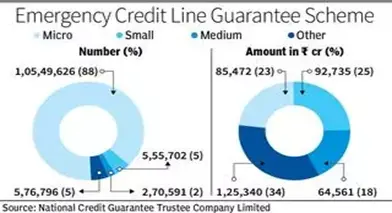
About Emergency Credit Line Guarantee Scheme:
- Launch:
- Introduced by the Government of India in 2020 as a special scheme in response to the Covid-19 crisis.
- Objective:
- To provide 100 percent guaranteed coverage to banks, non-banking financial institutions (NBFCs), and other lending institutions for extending emergency credit to business entities impacted by the Covid-19 pandemic, aiding them in meeting their working capital requirements.
- Operational Domain:
- Administered by the Ministry of Finance, Department of Financial Services (DFS).
- Implementation:
- Managed by the National Credit Guarantee Trustee Company Ltd (NCGTC), established by the Union Ministry of Finance to oversee and provide guarantees for these loans.
- Phases:
- Launched in multiple phases: ECLGS 1.0, ECLGS 2.0, ECLGS 3.0, and ECLGS 4.0, each expanding the scheme's scope to include various sectors.
- Sanctions/Disbursements:
- Carried out by lending institutions based on their assessment of the borrower’s requirements and eligibility.
- Charges:
- Processing charges, foreclosure, and prepayment charges are waived under the scheme.
- Collateral:
- No collateral is required for this scheme.
|
UPSC Civil Services Examination, Previous Year Questions (PYQs) Prelims Q:1 Pradhan Mantri MUDRA Yojana is aimed at (2016)
Ans: (a)
Q:2 With reference to the Non-banking Financial Companies (NBFCs) in India, consider the following statements: (2010)
Which of the statements given above is/are correct?
Ans: (b) |
Source: TH
Chagos Archipelago
Why in the news:
- Recently, the external affairs minister affirmed that India will continue supporting Mauritius on the Chagos Archipelago issue, consistent with its stance on decolonization.
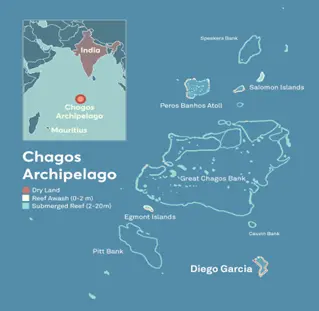
About Chagos Archipelago:
- Location:
- An island group situated in the central Indian Ocean, approximately 1,000 miles (1,600 km) south of the southern tip of the Indian subcontinent.
- Territorial Status:
- An overseas territory of the United Kingdom, established on November 8, 1965.
- Key Islands:
- Notable islands include Diego Garcia atoll (which hosts a strategic US military base), Danger Island, Egmont Islands, Eagle Islands, Nelsons Island, and Peros Banhos atoll.
- Climate:
- The archipelago experiences a tropical marine climate characterised by high temperatures and elevated humidity levels, with the climate being significantly moderated by the trade winds.
Chagos Island Dispute:
- Background:
- The Chagos dispute centres around the archipelago in the Indian Ocean, claimed by Britain along with Mauritius in 1814.
- Lease to the United States:
- In 1966, Britain leased Diego Garcia, the largest of the Chagos Islands, to the United States for use as a military base.
- Chagossians' Legal Battle:
- The Chagossians, primarily descendants of African slaves brought to the islands in the 18th century, have been engaged in a prolonged legal battle for the right to return to their homeland.
- Mauritius' Claim:
- Mauritius, which gained independence from Britain in 1968, has consistently asserted its claim over the Chagos Islands.
- International Court of Justice Ruling:
- In 2019, the International Court of Justice (ICJ) dismissed the UK's right to govern the Chagos Islands and called on the UK government to withdraw from the archipelago.
Source: HT
ADB retains India growth forecast at 7% for FY25
Why in the news?
- The Asian Development Bank (ADB) recently retained India’s GDP growth forecast for the current financial year at 7%.
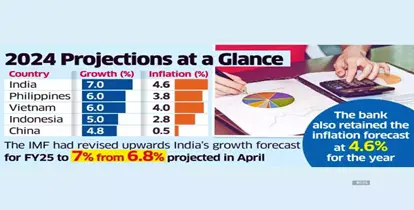
About Asian Development Bank (ADB):
- Establishment:
- The ADB is a multilateral development bank established on 19th December 1966.
- Principal Role:
- It serves as the principal international development finance institution for the Asia-Pacific region.
- Vision:
- ADB envisions a prosperous, inclusive, resilient, and sustainable Asia and the Pacific while striving to eradicate extreme poverty in the region.
- Functions:
- Assistance: Provides grants, loans, technical assistance, and equity investments to its developing member countries, the private sector, and public-private partnerships to promote social and economic development.
- Maximising Impact: Facilitates policy dialogues, provides advisory services, and mobilises financial resources through cofinancing operations that leverage official, commercial, and export credit sources.
- Headquarters:
- Manila, Philippines.
- Membership:
- Eligibility: Open to members and associate members of the United Nations Economic Commission for Asia and the Far East, other regional countries, and non-regional developed countries that are members of the U.N. or any of its specialised agencies.
- Growth: From 31 members at its establishment in 1966, ADB has expanded to 68 members, with 49 from within Asia and the Pacific and 19 from outside the region.
- Control:
- Board of Governors: The ADB is governed by a board of governors representing the member countries.
- Voting System: Modelled closely on the World Bank, the ADB has a weighted voting system where votes are distributed in proportion to members' capital subscriptions.
- Largest Shareholders: As of 2022, the five largest shareholders are Japan and the United States (each with 6% of total shares), the People's Republic of China (6.4%), India (6.3%), and Australia (5.8%).
- Source of Funding:
- Capital Raising: Regularly raises capital through the international bond markets.
- Additional Sources: Relies on member contributions, retained earnings from lending, and loan repayments for funding
|
UPSC Civil Services Examination, Previous Year Question (PYQ) Prelims: Q:1 Consider the following statements: (2020)
Which of the statements given above is/are correct?
Ans: (b)
Q: 2 The term ‘Regional Comprehensive Economic Partnership’ often appears in the news in the context of the affairs of a group of countries known as (2016)
Ans: (b)
Mains Q:1 Evaluate the economic and strategic dimensions of India’s Look East Policy in the context of the post-Cold War international scenario. (2016) |
Source: FE
Scientists discover a new microcontinent
Why in the news?
- A microcontinent has been recently discovered in the Davis Strait, located between Canada and Greenland.
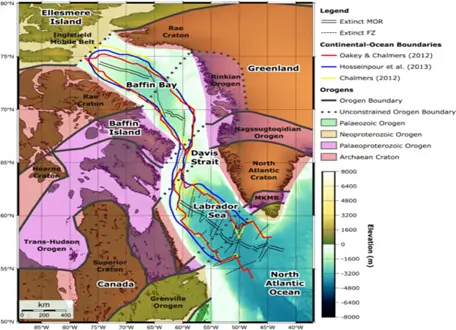
About the Newly Discovered Microcontinent:
- Location:
- The discovery was made in the Davis Strait, a large stretch of water between Canada’s Baffin Island and Greenland.
- Formation:
- The strait was formed millions of years ago due to tectonic plate shifts between the two islands, reconfiguring the Earth’s crust.
- This tectonic activity resulted in the formation of a thick continental crust in the ocean, now recognized as a primitive microcontinent.
- Naming:
- The microcontinent has been named the Davis Strait proto microcontinent, attributed to the tectonic evolution of the strait in the region.
- Characteristics:
- The microcontinent features a 19–24 km thick thinned continental crust, surrounded by two narrow bands of thin (15–17 km) continental crust.
Key Facts about Davis Strait:
- Geography:
- Also known as the northern arm of the Atlantic Ocean.
- Located north of the Labrador Sea, between southwestern Greenland and southeastern Baffin Island in Nunavut, Canada.
- Separates the northern Baffin Bay from the southern Labrador Sea.
- Forms a part of the Northwest Passage, connecting the Atlantic and Pacific Oceans through the Canadian Arctic Archipelago.
- Baffin Bay:
- Positioned between Baffin Island and Greenland’s west coast.
- Defined as a marginal sea of the Arctic Ocean and considered a small sea of the North Atlantic.
- Not navigable in winter due to thick ice cover, floating icebergs, and heavy fog.
- Dimensions:
- The Davis Strait extends approximately 400 miles (650 km) north to south and is 200 to 400 miles wide.
- Water depth ranges from 1000 to 2000 metres, making it shallower than the southern Labrador Sea.
- Geological Formations:
- Home to complex geological features such as underwater basins and ridges.
- Formed due to strike-slip faulting along the Ungava Fault Zone around 45 to 62 million years ago, triggering tectonic movements in the Labrador Sea and Baffin Bay.
- Ocean Currents:
- Two different ocean currents, with contrasting temperatures, influence the Davis Strait.
- The western Greenland current carries warmer waters towards the east from Greenland’s shores.
- The Labrador current moves iceberg-filled water southward along the Canadian coast, the Labrador Sea, and the Atlantic.
- Ice conditions reflect this flow regime, with heavy ice movement and icebergs along the western shore, contrasting sharply with more open water along the Greenland side.
Source: TOI
India’s Blue Economy Potential
Context:
- India's Deep Ocean Mission, Samudrayaan, aims to harness the Blue Economy by exploring and using ocean resources sustainably.
- The mission focuses on developing tools for climate change prediction, exploring renewable energy, and establishing underwater research labs.
- India needs to balance resource extraction with sustainable practices and responsible development.
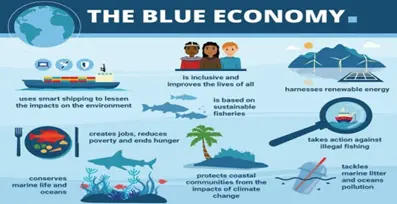
What are the Major Opportunities Related to the Blue Economy for India?
- Sustainable Fisheries and Aquaculture:
- India's extensive coastline and inland water resources offer significant potential for developing sustainable fisheries and aquaculture.
- The Pradhan Mantri Matsya Sampada Yojana (PMMSY) is transforming the sector by promoting technology-driven, sustainable practices.
- Ocean Energy:
- India's coastline has vast potential for ocean energy, including tidal, wave, and offshore wind power.
- A notable advancement is IIT Madras's deployment of a wave energy generator off the Tamil Nadu coast.
- The government's goal of installing 30GW of offshore wind capacity by 2030 highlights the sector's potential.
- Marine Biotechnology:
- Exploring India's marine biodiversity for biotechnological applications presents a frontier with immense potential.
- This sector offers opportunities for developing novel drugs, nutraceuticals, cosmeceuticals, and biofuels.
- Investing in marine biotechnology could position India as a leader in this emerging field, driving innovation and creating high-value products.
- Seabed Mining:
- one for polymetallic nodules in the Central Indian Ocean Basin and the other for polymetallic sulfides in the Indian Ocean Ridge.
- This provides a significant opportunity to obtain critical minerals like copper, nickel, cobalt, and manganese, which are essential for emerging technologies and renewable energy systems.
- Coastal and Cruise Tourism:
- Developing coastal and cruise tourism offers substantial economic benefits for India's coastal regions.
- The Sagarmala programme's plans for cruise terminals at major ports such as Mumbai and Cochin aim to tap into the growing global cruise market.
- This sector can create diverse employment opportunities, from hospitality to local handicrafts, and promote cultural exchange.
- Shipbuilding and Ship Recycling:
- India's ₹4,000 crore subsidy scheme for shipbuilding presents opportunities for both new ship construction and the development of environmentally friendly ship recycling practices.
- The Recycling of Ships Act, 2019, positions India to become a global leader in sustainable ship recycling, generating significant employment, boosting exports, and contributing to ancillary industries.
- Desalination Technologies:
- With growing water scarcity issues, India's focus on developing cost-effective desalination technologies is timely.
- The Low Temperature Thermal Desalination (LTTD) plant in Lakshadweep, developed by NIOT, demonstrates India's capability in indigenous desalination technology.
- This sector offers opportunities to address domestic water needs, especially in coastal and island regions, and position India as an exporter of desalination technology to water-stressed nations.
- Marine Spatial Planning:
- Implementing comprehensive marine spatial planning is essential for balancing economic activities with conservation efforts in India's maritime zones.
- The Blue Flag certification program, which includes certified Indian beaches like Shivrajpur (Dwarka, Gujarat) and Ghoghla (Diu), exemplifies efforts towards sustainable coastal development.
- Deep Sea Exploration and Research:
- The Deep Ocean Mission, launched in 2021, marks India's ambitious entry into deep-sea exploration.
- The development of the manned submersible vehicle MATSYA 6000, capable of reaching depths of 6,000 metres, will greatly enhance India's deep-sea research capabilities.
What are the Major Challenges Related to the Blue Economy for India?
- Environmental Degradation and Biodiversity Loss:
- Over 65% of coral reefs in the Indian Ocean and Middle East are threatened. The Sundarbans mangrove forest loses 16 sq km annually due to sea-level rise and erosion.
- The 2020 MV Wakashio oil spill near Mauritius highlights marine ecosystem vulnerability.
- Overfishing and Unsustainable Fishing Practices:
- A 2022 ICAR-Central Marine Fisheries Research Institute report found 8.2% of India's 135 fish stocks overfished and 4.4% overfishing.
- Practices like bottom trawling worsen the situation.
- Climate Change and Sea-Level Rise:
- A 3 cm sea level rise could push the sea inland by 17 metres, affecting infrastructure and livelihoods.
- Cyclone Amphan in 2020, causing USD 13.5 billion in damages, illustrates this vulnerability.
- Marine Debris:
- India generates about 9.46 million tonnes of plastic waste annually, with significant amounts ending up in the oceans.
- Microplastics in marine food chains pose risks to both marine life and human health.
- Balancing Economic Development with Conservation:
- Balancing resource exploitation with conservation is challenging.
- For example, the Great Nicobar Island port project faces criticism for potentially harming rainforests and coral reefs.
- Maritime Security and Piracy:
- Maritime security in the Indian Ocean Region is crucial. Piracy and transnational crimes pose significant risks, with 120 incidents reported in 2023.
- Limited Research and Development:
- India's marine R&D investment is limited compared to other nations.
- Research expenditure is less than 1% of the total R&D budget, significantly lower than China and the US.
What Actions India Can Take to Foster a Sustainable Blue Economy?
- Sustainable Fisheries and Aquaculture Management:
- Implement a fisheries management plan with quotas, sustainable aquaculture techniques, and traceability systems to address overfishing and promote sustainability.
- The Marine Stewardship Council certification for Kerala’s Ashtamudi clam fishery shows the potential for sustainable practices.
- Integrated Coastal Zone Management:
- Adopt a holistic coastal management approach with strict regulations on construction and pollution, nature-based solutions like mangrove restoration, and community engagement through eco-tourism.
- The Integrated Coastal Zone Management Project in Gujarat and Odisha offers a model for wider implementation.
- Marine Pollution Control and Waste Management:
- Address marine pollution by enforcing discharge regulations, enhancing wastewater treatment, and adopting extended producer responsibility (EPR) for plastics.
- Circular economy initiatives like the Plastics Disclosure Project also help reduce pollution.
- Advanced Maritime Security and Surveillance:
- Enhance maritime security by upgrading surveillance with AI-powered drones and satellite monitoring and strengthening the Indian Coast Guard and Navy.
- Improving coordination among maritime agencies is crucial, with the Information Fusion Centre – Indian Ocean Region (IFC-IOR) being a key step.
- Skill Development and Capacity Building in Maritime Sectors:
- Launch skill development programs for offshore energy, marine biotechnology, and sustainable fisheries.
- Expand the Sagarmala programme’s coastal community development component for nationwide skill development.
- Research and Innovation in Marine Technology:
- Increase investment in marine R&D, promote academia-industry collaboration, and establish innovation hubs in coastal cities.
- Expand the Technology and Innovation in Exploration and Mining of Deep-sea Resources (TEM) programme.
- Coastal Disaster Risk Reduction and Resilience Building:
- Develop coastal hazard maps, implement nature-based solutions like mangrove restoration, and strengthen early warning systems.
- The National Cyclone Risk Mitigation Project provides a framework for addressing coastal hazards and climate change impacts
|
UPSC Civil Services Examination, Previous Year’s Question (PYQs) Mains Q:1 Defining blue revolution, explain the problems and strategies for pisciculture development in India. (2018) |
Source: ET
Share the article
Edukemy’s Current Affairs Quiz is published with multiple choice questions for UPSC exams
MCQ
Get Latest Updates on Offers, Event dates, and free Mentorship sessions.

Get in touch with our Expert Academic Counsellors 👋
FAQs
UPSC Daily Current Affairs focuses on learning current events on a daily basis. An aspirant needs to study regular and updated information about current events, news, and relevant topics that are important for UPSC aspirants. It covers national and international affairs, government policies, socio-economic issues, science and technology advancements, and more.
UPSC Daily Current Affairs provides aspirants with a concise and comprehensive overview of the latest happenings and developments across various fields. It helps aspirants stay updated with current affairs and provides them with valuable insights and analysis, which are essential for answering questions in the UPSC examinations. It enhances their knowledge, analytical skills, and ability to connect current affairs with the UPSC syllabus.
UPSC Daily Current Affairs covers a wide range of topics, including politics, economics, science and technology, environment, social issues, governance, international relations, and more. It offers news summaries, in-depth analyses, editorials, opinion pieces, and relevant study materials. It also provides practice questions and quizzes to help aspirants test their understanding of current affairs.
Edukemy's UPSC Daily Current Affairs can be accessed through:
- UPSC Daily Current Affairs can be accessed through Current Affairs tab at the top of the Main Page of Edukemy.
- Edukemy Mobile app: The Daily Current Affairs can also be access through Edukemy Mobile App.
- Social media: Follow Edukemy’s official social media accounts or pages that provide UPSC Daily Current Affairs updates, including Facebook, Twitter, or Telegram channels.

